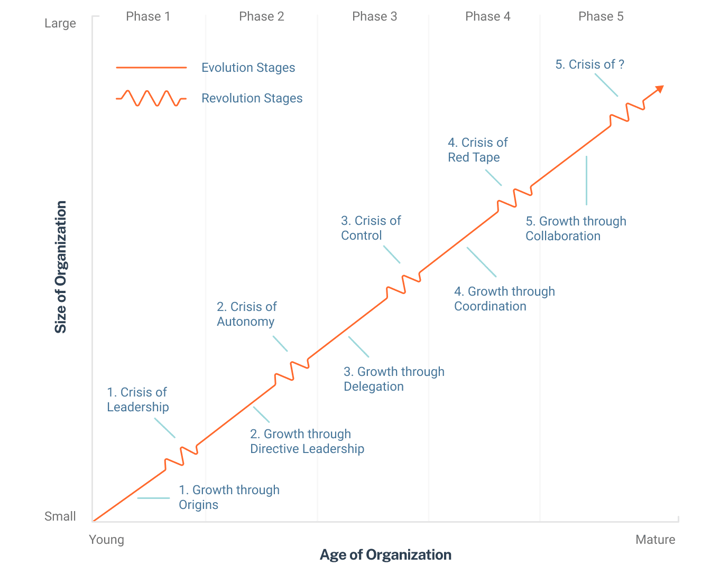Phases of Growth and Crisis in the Life of Nonprofits

You’re on a mission. You have a bold and righteous ambition to end homelessness, eliminate childhood hunger, or stop sex trafficking.
As with any business, survival for nonprofits is all about continued growth. But previous management decisions can doom even the mightiest or noblest of them all.
For example, is your management system completely centralized? If so, your hands-tied program managers and team leaders may be increasingly disenchanted and unmotivated.
Or conversely, perhaps you’ve given lower-level management considerable autonomy. You may want to check the mounting frustration level of your executive team.
As noted in both instances, previous management actions–centralizing or giving autonomy–resulted in unwanted consequences that can eventually stop any nonprofit dead in its tracks.
In essence, management actions taken in the past will probably become your next major growth obstacle. And what worked to overcome such an obstacle before won’t work again.
Back in 1972, Larry Greiner developed his classic organizational growth model. Its obvious application involves for-profit companies with terms such as manufacturing, inventory, industry growth rate, and profit centers.
Nonetheless, it provides a basis adaptable to nonprofits, because the primary forces inhibiting growth are not ethereal things like supply chains or inflation. Not really.
Rather, the main growth inhibitors are human decisions based on a management crisis.
And that’s certainly applicable to all business sectors, including nonprofits! So let’s get into it using Greiner’s terms of evolution and revolution.
EVOLUTION = Quiet time of growth, which eventually leads to a revolution
REVOLUTION = Current systems are now inappropriate, and new ones must be found to transition us to the next evolution (which will bring us to the next revolution, and so on)
Isn’t it ironic that each major solution fosters the next major problem?
But I digress. The main point is that as a nonprofit matures, it typically won’t remain the same (unless growth is purposely shunned by management). It either grows due to successful management changes, or it dies.
If the organization lasts long enough, it will generally go through five key phases—each marked by evolution (growth) and revolution (crisis)—that will result in either its continued existence or its demise.

PHASE 1 Evolution – Growth through Origins
What an exciting time for any nonprofit. Once the idea and the “why there’s a need for us” is baked, the nonprofit is founded with almost limitless entrepreneurial energy.
Getting it off the ground means acquiring some funding and creating a diverse board that has more hands-on work to do than time to do it.
Someone has to acquire the 501(c)(3) status, develop board by-laws, find a location, tinker with program design—initially, it’s all eagerly handled with frequent, informal communication. And it finally takes off with somewhat of a roar.
But with initial operating success comes employees, accounting, grant requirements, websites, email, and everything else indicative of a real nonprofit. These management activities are disdained by the entrepreneurial founders, who now find themselves with unwanted responsibilities.
Thus…PHASE 1 Revolution – The Leadership Crisis
No longer a kitchen-table idea, the nonprofit is in need of more formalized management complete with a business plan, procedures, roles, expectations, sustained fundraising plans, and the like.
The founders are loath to step aside, but know they are neither eager nor suited to take on such “mundane” responsibilities. Plus, the board itself needs to transition from being hands-on to one that provides strategic governing.
Consequently, a capable manager (we’ll call this person a CEO) must be put in place to lead the nonprofit out of crisis and into the next evolution (growth) phase.
PHASE 2 Evolution – Growth through Directive Leadership
Now driving daily operations, the CEO or executive team uses directive (basically one-way and unshared) leadership to craft a more focused organization. Technology systems are introduced for such activities as accounting, human resources, and the all-important fundraising.
A new functional structure is put in place that specifies responsibilities and staff hierarchy. And because no one in this now-expanded organization can know everything anymore, it formalizes communication policies to ensure all appropriate people are informed.
Current programs are broadened to meet more constituent needs. Plus, a strong strategic plan is created to scale the nonprofit’s development, both for funding and capacity purposes.
This all sounds really good. Until it’s not.
Thus…PHASE 2 Revolution – The Autonomy Crisis
As the nonprofit becomes larger and more complex, directive leadership is increasingly unsuitable.
For one thing, lower-level workers know more about clients and their needs than do top managers. Would a CEO realize, for instance, that nine participants in a particular program barely know any English and that three need a Zapotec interpreter?
The program manager may desperately want to hire needed translators but is hamstrung by a rigorous expenditure policy. As such, more autonomy is needed at that level to take the initiative for a smoother-running program.
For another thing, communication is more impersonal, further alienating lower-level staff.
Numerous organizations are curiously hesitant to grant autonomy, even as those in the trenches become disenchanted and quit. Only those nonprofits who understand the need to delegate will thrive going forward.
PHASE 3 Evolution – Growth through Delegation
To course-correct from the crisis caused by directive leadership, management shifts to delegation for continued growth.
Greater responsibility is given to now motivated mid-level managers, enabling them to make their own tactical decisions. Communication from above is infrequent and usually in writing.
Conversely, now freed from directive leadership, the CEO can concentrate more on broad-ranging efforts like community relations and fundraising from major sources.
By now, the nonprofit also has a well-established reputation, with its programs outcomes-based and in sync with a well-thought-out strategic plan. Moreover, far from all the eggs in one basket, funding streams are varied to support specific program needs.
For a while, things have never looked better. But all good things come to an end.
Thus…PHASE 3 Revolution – The Control Crisis
Eventually, a serious control crisis stands in the way of growth.
This is typified by several factors, not the least of which is top management feeling as if they’re losing control over the more diversified, autonomously run operations. Attempts to return to directive leadership fail due to the nonprofit’s now expanded size.
To exacerbate matters, mid-level managers are now protecting territories previously delegated to them. They’re not anxious to relinquish any control or coordinate resources with others in the organization.
With such a management stalemate, the nonprofit can lose touch with its constituency, instead of focusing on making necessary changes to meet evolving community needs.
This impasse can also signal a nonprofit in decline with little hope of growth. At this point, successful nonprofits shift to management based on some level of coordination.
PHASE 4 Evolution – Growth through Coordination
This growth phase sees the birth of formal systems designed to enhance coordination among the various nonprofit departments. Top management takes responsibility for creating and implementing these systems.
While some functions like accounting become (or stay) centralized, daily operating decisions are still left to mid-level managers. However, they must now carefully justify these decisions to administrative staff.
Additionally, various groups may be merged into the same team. For example, counselors assigned to family programs and those to anger management may be merged into one group to optimize their scheduling.
The use of formal systems to coordinate efforts means everyone is expected to play their part.
Think of it like taking a photo at a family reunion with 50 people. Someone has to round them up. Then someone needs to have them stand in a certain order (tall ones in back), and someone has to take the picture. And each of the 50 participants has a role in this as well—they’re tasked to say “Cheese!” or to “Smile!”
Growth once again occurs until it hits the inevitable snag. As in other phases, the next problem encountered results from the previous solution.
Thus…PHASE 4 Revolution – The Red Tape Crisis
Mistrust begins to build between program managers and administrative staff. People “on the ground” resent staff who know little about serving up programs, and staff resents these uncooperative managers.
While pointing the finger at each other, both groups also point to a formal, overly bureaucratic system that favors procedure over problem solving. Certainly, innovation is out the window.
The nonprofit is too large and/or complex to be managed with rigid processes. It’s mired in red tape, a condition that may be overcome with some measure of collaboration.
PHASE 5 Evolution – Growth through Collaboration
Attempting to put the red tape crisis out to pasture, nonprofits will initiate collaboration as the guiding management principle.
This phase is characterized by notable interpersonal communication and collaboration. The formal procedures leading to the red tape crisis are replaced with on-the-fly problem-solving actions through teams.
Self-discipline and social control (e.g., praise, respect, disappointment, etc.) instead of formality, frequent key-manager meetings instead of resentment—these are hallmarks of the collaboration phase. Additional pillars include behavioral skill training and the encouragement of new-practice experiments.
To me, this phase of growth comes down to the skillful management of your most valued asset: Your People.
So, what revolution will collaboration lead to?
That’s kind of an unknown. Greiner thinks it may be exhaustion from continuous teamwork and the pressure for innovation. If so, that crisis may in turn be resolved by periodic revitalization—spa days, if you will.
Want to find out what stage of growth you're in?
A few growth considerations for nonprofit managers…
1. Know which evolution or revolution you’re in
As top management, you need to know where you are within the sequence of organizational growth. Otherwise, how will you know what changes are needed and when?
Sure, collaboration in the last growth phase seems to be the desired management technique fancied by many nonprofits.
However, skipping phases that come before this is not recommended. Like adding increasingly more pushups to your exercise routine, each evolution and revolution builds needed strengths for future success. You’ll know from experience what works, what doesn’t, and why.
Specifically, revolutions are periods of tension that greatly disturb the status quo, forcing needed change and new ideas. You won’t want to miss that!
Who knows? Yours may even be an organization that operates well with hybrid management—something you wouldn’t know if you didn’t go through it all.
2. Considerable self-awareness is needed by top management
As noted in this article, each revolution—that is, each period of genuine crisis—can be overcome only by applying certain new solutions. Retreads of those adopted in earlier phases will make it virtually impossible for new growth to occur.
You have to be prepared to act when you find your nonprofit in a revolution. That means:
- Convincing other managers that change is required
- Tearing down the current management system
- Introducing a new system that curbs the crisis AND is appropriate for the next growth phase
- Replacing yourself (and/or others) if managerial styles are no longer suitable
These actions require significant self-awareness and dedication to the organization. But if your nonprofit is in crisis, you likely have no choice if you want it to thrive.
3. Solutions for a crisis eventually cause the next major problem
Often overlooked by management, today’s solutions are tomorrow's headaches.
For example, putting directive management in place after a nonprofit is founded is a good move but eventually leads to a crisis of autonomy. Giving autonomy to mid-level managers leads to a crisis of control. Fixing control issues leads to a crisis of red tape.
Leaders may blame crises on current circumstances or developments.
But if they’re aware that each new crisis will eventually arise because of previous management actions (and not what’s happening today), they’re well positioned to predict and manage it.
When it comes to organizational growth, look behind to see what’s ahead!
Want to find out what stage of growth you're in?





